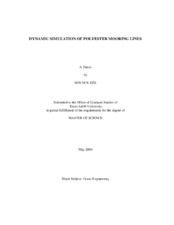| dc.description.abstract | A numerical scheme, known as CABLE3D, originally developed for the simulation of dynamics of steel chain-wire mooring lines is extended to allow for the large elongation in a mooring line, the dependence of the modulus on tension, and energy dissipation of a polyester rope under mean and cyclic loads. The modified CABLE3D is then integrated into a numerical package, known as COUPLE6D, for computing the interaction between a floating structure and its hybrid polyester mooring system. The Deepstar Spar is chosen in this study to represent the floating structure.
By considering large elongation in polyester ropes in numerical simulation, the static offset curve of a polyester mooring system is softer than that calculated under the assumption of small elongation. That is, about 10% reduction in restoring force at the mean offset position of the Spar under the impact of 100-year hurricane storm. The effects of the mean loads on the modulus of polyester ropes are much greater than those of the dynamic loads. Hence, the former is more important in the simulation of the response of floating structures. The energy dissipation in polyester ropes under cyclic loading does not play significant roles in the responses of the Spar and tensions in a polyester mooring system. The above findings, although observed based on the numerical simulation of a particular floating structure, namely Spar, may have implications to other floating offshore structures moored by a polyester mooring system.
Two systems are simulated in two different met-ocean conditions: hurricane and loop current condition. To study the properties of polyester, numerical simulation were conducted in three ways. Those are related to the modulus based on mean load, mean and dynamic loads, and structural damping respectively. Through the simulation, statistics of motions of the hull and tension in the mooring lines are compared with those of a conventional steel mooring system. | en |


